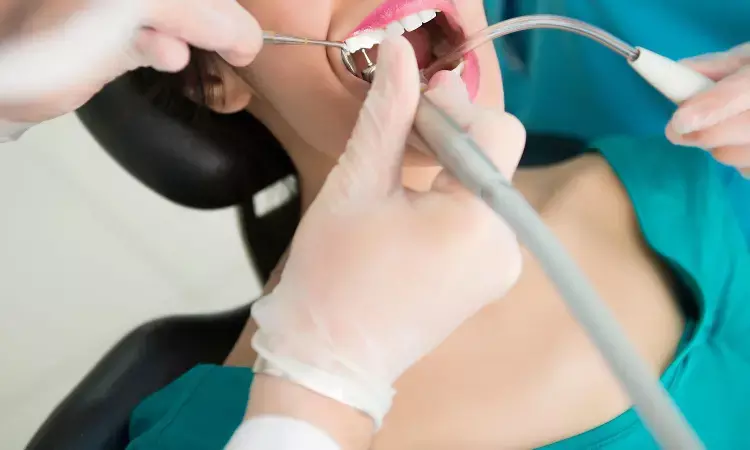- Home
- Medical news & Guidelines
- Anesthesiology
- Cardiology and CTVS
- Critical Care
- Dentistry
- Dermatology
- Diabetes and Endocrinology
- ENT
- Gastroenterology
- Medicine
- Nephrology
- Neurology
- Obstretics-Gynaecology
- Oncology
- Ophthalmology
- Orthopaedics
- Pediatrics-Neonatology
- Psychiatry
- Pulmonology
- Radiology
- Surgery
- Urology
- Laboratory Medicine
- Diet
- Nursing
- Paramedical
- Physiotherapy
- Health news
- Fact Check
- Bone Health Fact Check
- Brain Health Fact Check
- Cancer Related Fact Check
- Child Care Fact Check
- Dental and oral health fact check
- Diabetes and metabolic health fact check
- Diet and Nutrition Fact Check
- Eye and ENT Care Fact Check
- Fitness fact check
- Gut health fact check
- Heart health fact check
- Kidney health fact check
- Medical education fact check
- Men's health fact check
- Respiratory fact check
- Skin and hair care fact check
- Vaccine and Immunization fact check
- Women's health fact check
- AYUSH
- State News
- Andaman and Nicobar Islands
- Andhra Pradesh
- Arunachal Pradesh
- Assam
- Bihar
- Chandigarh
- Chattisgarh
- Dadra and Nagar Haveli
- Daman and Diu
- Delhi
- Goa
- Gujarat
- Haryana
- Himachal Pradesh
- Jammu & Kashmir
- Jharkhand
- Karnataka
- Kerala
- Ladakh
- Lakshadweep
- Madhya Pradesh
- Maharashtra
- Manipur
- Meghalaya
- Mizoram
- Nagaland
- Odisha
- Puducherry
- Punjab
- Rajasthan
- Sikkim
- Tamil Nadu
- Telangana
- Tripura
- Uttar Pradesh
- Uttrakhand
- West Bengal
- Medical Education
- Industry
Oral health and acute ischemic stroke linked to carotid atherosclerosis

A new study proposed that the association between poor oral health and acute ischemic stroke is linked to carotid atherosclerosis. The article was published in the Stroke research and treatment. Ischemic stroke is a serious condition characterized by the sudden loss of blood circulation to an area of the brain.
Carotid artery atherosclerosis is an important cause of large vessel disease and ischemic stroke Risk of acute ischemic stroke has been associated with carotid artery atherosclerosis as well as with periodontal disease. DNA of bacteria typical for both endodontic and periodontal infections have earlier been found in cerebral aneurysms, in thrombus aspirates of patients with acute myocardial infarction and lower limb arterial and deep venous thrombosis.
In all these studies, the most frequently found bacterial DNA belonged to the Streptococcus mitis group, which belongs to the viridans group streptococci. Viridans streptococci species are a known cause of infective endocarditis. However, we do not know what the origin of streptococci in thrombus aspirates is.
Bacteria may gain access to the systemic circulation via the root canal of infected teeth or through the periodontal pocket and may end up in a thrombus because viridans streptococcal species possess thrombogenic properties. As odontogenic infection has been associated with the development of carotid artery disease and rupture of the atherosclerotic plaque, it may be possible that streptococci originate from complicated
carotid plaques. Olli Patrakka, Tampere University and Fimlab Laboratories, Finland and colleagues applied dental radiography as well as carotid radiological imaging to determine whether oral pathology or carotid atherosclerosis was associated with the presence and quantity of bacterial DNA in their aspirated thrombi.
Researchers included 71 patients (70.4% male; mean age, 67.4 years) with acute ischemic stroke in the study. Research team took Thrombus aspirates and control arterial blood from the patients. Tooth pathology was registered using CT scans.
Carotid stenosis was estimated with CTA and ultrasonography. The presence of bacterial DNA from aspirated thrombi was determined using quantitative PCR. The presence of the bacterial DNAs in carotid endarterectomise was also analyzed in patients with peripheral arterial disease.
Key findings of the study,
1. Bacterial DNA was found in 83.1% of the thrombus aspirates (median, 8.6-fold).
2. Oral streptococcal DNA was found in 78.9% of the thrombus aspirates (median, 5.1- fold). DNA from A. actinomycetemcomitans and P. gingivalis was not found.
3. Most patients suffered from poor oral health and had a median of 19.0 teeth left.
4. Ironically, patients with better oral health had more oral streptococcal DNA in their thrombus than the group with the worst pathology (p = 0.028).
5. There was a trend (OR 7.122; p = 0.083) in the association of ≥50% carotid artery stenosis with more severe dental pathology.
6. Oral streptococcal DNA was detected in 2/6 of carotid endarterectomies.
The authors conclude that stroke patients have poor oral health which tended to associate with their carotid artery stenosis. Though oral streptococcal DNA was found in thrombus aspirates and carotid endarterectomy samples, the amount of oral streptococcal DNA in thrombus aspirates was the lowest among those with the most severe oral pathology.
The results suggest that the association between poor oral health and acute ischemic stroke is linked to carotid artery atherosclerosis. Future studies to determine whether oral bacteria have a role in the pathogenesis of acute ischemic stroke or they are solely the bystanders, are needed.
Reference:
Patrakka O, Mehtonen H, Tuomisto S, Pienimäki JP, Ollikainen J, Huhtala H, Pessi T, Oksala N, Lehtimäki T, Järnstedt J, Martiskainen M, Karhunen PJ. Association between Oral Pathology, Carotid Stenosis, and Oral Bacterial DNA in Cerebral Thrombi of Patients with Stroke. Stroke Res Treat. 2021 Sep 7;2021:5402764. doi: 10.1155/2021/5402764. PMID: 34531969; PMCID: PMC8440111.
Dr Kamal Kant Kohli-MBBS, DTCD- a chest specialist with more than 30 years of practice and a flair for writing clinical articles, Dr Kamal Kant Kohli joined Medical Dialogues as a Chief Editor of Medical News. Besides writing articles, as an editor, he proofreads and verifies all the medical content published on Medical Dialogues including those coming from journals, studies,medical conferences,guidelines etc. Email: drkohli@medicaldialogues.in. Contact no. 011-43720751
Next Story


